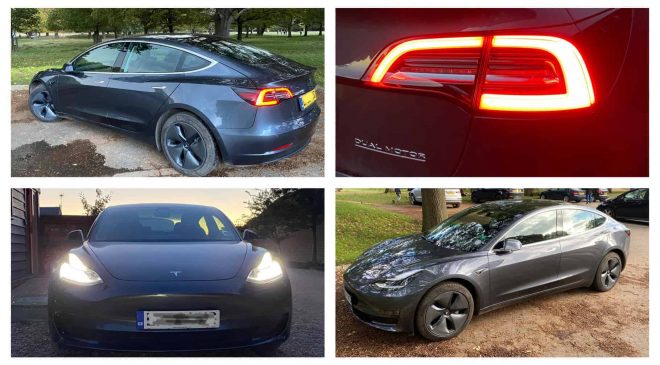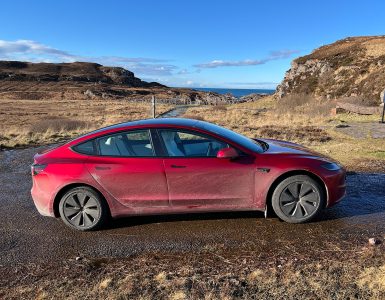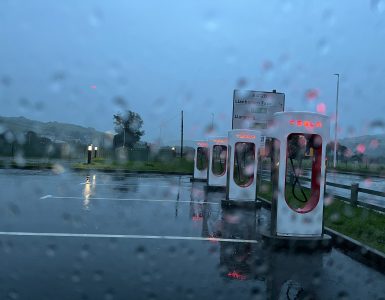Well after over 8,000 miles in the Tesla Model 3 it really isn’t that hard at all in this electric car. Have I ever had to drive 20 miles out of my way to find a working charger? Yes, Have trips had to be adapted a little? Yes there are more frequent service station stops where you plugin for 15 to 30 mins but that’s not a disaster, after all a stretch, a tea and “rest stop” are what you should do to stay fresh and alert on a long drive. This pure electric marvel has handled everything thrown at it with ease and aplomb and while defying all performance norms for the piston cars before it.
Is it difficult to switch from petrol or diesel to an electric car?
Over 90% of electric car drivers say they would never go back to driving a piston powered petrol or diesel car and that is my experience too. Even if cars like a BMW 3 series, or an X5 or a Range Rover or Porsche 911 were halved in price, I still wouldn’t be interested! When you realise cars don’t actually need to be noisy, or have jerky mechanical gears, or have to warm up on a cold day or burn polluting fossil fuel it changes your whole view of combustion engine cars. Once you drive EVs you perceive them as the present and the future and piston cars are as much “yesterday” as a cathode ray TV set, whether its an old combustion car or one that rolled off the production line a week ago. It’s just not everyone knows it yet.

Model tested: 8,000+ miles in a UK Tesla Model 3 Performance minus*
*This occasionally available Dual motor model has the same acceleration as a full Performance model but otherwise looks and behaves like a dual motor long range version.
Picking up the Model 3 only 6 months before the start of the global COVID pandemic meant journeys to see friends in Switzerland and Scotland were off the menu. Trips included the 2019 Low Carbon
Vehicle event at Millbrook in Beds and to Ludlow in Shropshire.
When the spring lockdown happened the Model 3 did a stint delivering PPE facemasks for medics that had been produced by the fab team at Augment Bionics. Trips included London Surrey, Herts and a couple of longer trips to Coventry and Birmingham.
Summer involved trips to Surrey, Sussex, Berks Oxfordshire, Cambridgeshire. Essex, Suffolk Dorset and Devon followed by some COVID inspired school runs in gridlocked SW London traffic. So pretty much all road types, speeds and temperatures covered.
For the price of a mid range stinking diesel premium SUV the Model 3 is:
- quieter than a limo like a Mercedes S Class in town
- As smooth as a Rolls
- accelerates as fast in this “Performance” model as a McLaren F1 V12 supercar (and faster than almost any piston saloon and most sports cars
- has instant throttle response that’s way quicker than piston cars especially automatics
- as safe as Volvo with advanced accident avoidance
- cheaper to run than a Fiesta
- probably costs less to service than a moped
- has loads of space for passengers and luggage even for longer family holiday trips
- has more advanced tech and entertainment than any other car I know
- and all the time it gets free updates making it better every month..fixing issues. adding new features and even improving performance and range all at no extra cost!
Interior design

The Model 3 is a very minimalist cool place to be and the forward visibility is great as the windscreen comes lower than most cars and is unobstructed except.. yes the door pillars help make it safe but they are thick. This applies to quite a few modern cars but it does mean sometimes sometimes you have to move your head to double check in the blind spot. It’s particularly an issue when stopping for one pedestrian at a crossing and needing to be sure another hasn’t arrived before you move forward.
The touch screen provides all the information and controls for the car. The screen is your dashboard, your speedo, your radio, navigation screen and controls. The only other physical controls are on the steering wheel along with switches for windows and door locks.

The controls overall work well and you quickly get used to it. The screen is clear and responsive and perfect for things like navigation.
In terms of design the interior and exterior door handles work fine but are quirky and need explaining to passengers the first time they travel in the car.
The seats are comfortable on long and short journeys and are vegan leather.. ie plastic. While popular with some, vegan leather is actually made of PVC so less sustainable and biodegradable than traditional leather. That said for PVC they feel soft comfortable and are easy to clean. All seats are heated front and back although standard range plus owners may need to pay to use back seat heaters.
Exterior design
Some have called the design of the Model 3 bland. Personally I think its a great, elegant design. Put next to a current BMW 3 Series which used to do understated elegance rather well but now has more creases than a bulldog, the Model 3 just looks like a classic natural design. Everything works well including the headlights which have been further improved for 2021 cars. I do think the rear lights look better on lit than off. The headlamps remind me of some 1990s Porsches.

Performance & refinement
All Model 3’s have phenomenal performance by piston car standards. The base Standard range plus kicks off with a 0-60 mph time of 5.6 seconds for around £40k while the dual motor long range now cuts this to 4.2 and this Performance Model manages around 3.2 secs! or 3.1 seconds in the latest cars! The fastest car I had previously owned was a 6 cylinder 330D Diesel automatic that I had bought in 2007. That had managed 0-60 in around 6.8 seconds so all the Model 3’s are in a completely different league and there is none of the hesitation and delay you get before pistons and gearboxes respond.

That’s not the whole story though. The fact the car moves with no fuss and responds smoothly, instantly and silently makes it super relaxing and calm to drive in any situation.
Easier braking brings cleaner air
Regenerative braking that lets you brake as well as accelerate using the motors in electric cars mean you rarely need to use the brake pedal itself- it’s a little like using a very low gear round bends in a “pistons and gears” car. It is available in most electric cars although for some you can only get a very mild braking effect while others are set (or can be adjusted) to give braking strong enough to allow what reviewers call “one pedal driving”.
Best of all
- using electric motors to slow the car puts some power back into your batteries instead of using your brake pads
- This means your brake pads wear less last longer (about 5 times longer!) and
- massively cuts brake dust which ends up as particulate or PM 2.5 /PM 10 in piston cars. This is responsible for thousands of deaths a year in the UK alone.
So while you often see frustrated piston car drivers stalling or lurching forward clanking through gears with smoke pouring out of their exhaust “van man style” to move a few yards before braking hard, in an electric car like a Model 3 you ease move forward then ease off the accelerator and come to a smooth stop, with the energy from slowing going back into your battery not wasted in brake dust. It’s just much much better, quieter and less stressful as it is in most EV’s.
Handling
The Model 3 handles confidently thanks to good levels of grip and batteries under the floor that give it much lower centre of gravity than piston cars. These keep it flat in corners without having an overly hard ride. It also feels completely planted even in atrocious driving conditions. The car’s weight also helps but for its size the Model 3 EV is very light.. around 1.7 to 1.8 tons which is about the same as the smaller VW ID.3.

This “performance minus” model came with 18” aero wheels rather than the normal 20” alloys so ride comfort is probably closer what you would expect in a long range dual motor model. It handles potholes and speed bumps well but like on most cars some surfaces do produce road noise especially on some of the concrete surfaced UK motorways.
A big plus is when you do see a typical small or medium sized hole in a UK road the Model 3 doesn’t tend to let its wheels fall into the hole with a big jolt like my old BMW 3 series but instead seems to just glide over them.
Efficiency, running costs & range
A updated new Model 3 that arrived in November 2020 has got increased range (largely thanks to new heat pump that is much more efficient in cold weather) & some prices have been reduced. The rear wheel drive standard range plus now has better range but if you can afford it the best all round choice is the mid range dual motor long range model.
In the first 7,500 miles this dual motor model 3 averaged 285 Wh/mile which works out at £68 per thousand miles at the 24p kWh that I pay on public lamp post chargers and on some Tesla superchargers. However electric car charging costs on public chargers vary wildly. 35p is an average price which would work at at £100 for 1,000 miles while charging off peak at home for 5p per kWh would cost you only £14 for 1,000 miles. Any chargers costing more than 50p a kWh are costing you more than a 35mpg piston car.

Efficiency is better in summer & below 60mph.. worse in winter, on motorways & in gridlocked traffic.
Servicing costs should be very low with a recommended brake and battery fluid top starting after 2 years. Brake pads should last 150,000 to 200,000 miles so if all goes well minimal cost and time off road for maintenance. So far its been zero days off the road after over 15 months.
Like all electric cars costing under £50,000 the Model 3 standard range plus and dual motor qualify for a £3,000 UK government grant along with zero VED, zero congestion & ULEZ charges and for people driving a company car there was zero BIK tax in 2020, 1% in 2021 and 2% in 2022 saving some drivers over £10k in tax over a 3 year lease.
Charging: High mileage drivers should be at home in a Model 3
The Model 3 is an excellent car but again and again reviewers say it’s decisive advantage is that running one gives to access to the Tesla Supercharger network.. and they are right. Compared to public charging networks Tesla is faster, easier and better value. While most public chargers being installed are only 50kWh in 2020 Tesla Superchargers come in hubs with between 6 and over 20 charging posts running at between 125kW and 250kW. You literally plug in and charge.. no apps, no screens, no logins.. not even a contactless card is needed and you are billed via your Tesla account. By contrast this is the current situation with more expensive slow public chargers in a Jan 2021 Autocar report
We have our own review of long distance travel in the Model 3 here
Range
Because range is 230-320 miles & charging on Tesla superchargers is easy, good value and very fast, long or very long journeys are no problem in a Model 3. London to inverness would be 4x 15 min charge stops on a roughly 11 hour drive during which time you can do a toilet stop and grab a coffee (or watch Netflix in the car!).
So what range and efficiency been like? Well over the first 5,000 this Model 3 delivered 285kWh per mile which is 3.5 miles per kWh. This equated to a roughly summer and winter annual mix. Now we are January 2021 (largely 2 winters and 1 summer) the average has crept up to 295kWh per mile (which is 3.38 miles per kWh). EV database list the usable battery size on this Sept 2019 Model 3 as 73.5kWh usable so average range over the 5,000 miles comes out at 257 miles (around 415km) or at the 295kWh per mile a range of 248 miles (around 400km).
Worst case range and efficiency
The reason efficiency is down since last summer is it has been doing short cold journeys in London traffic. This means warming up the car (see ventilation) and being stationary means any power draw (heating, screens, audio, FSD computer) have a proportionately bigger impact on efficiency per mile. In this driving the Model 3 is at its worst efficiency of around 450kWh per mile which is only 2.22 miles per kWh and equates to a range of only 163 miles (around 263 km). While this is poor it will improve in summer, will be much better on the new models equipped with heat pump heating and still equates to more than a week of daily use in town.
Driver aids for long distance driving
It’s also worth bearing in mind that although the Model 3 can’t (yet) drive itself the autopilot and optional FSD features can already manage most motorway drives with full supervision. In future updates and with planned changes in UK law from 2021 there will come a time when your Model 3 will be able to drive you on the motorway sections with no supervision. While original UK plans envisaged self driving at speeds of up to 70mph initial plans are now for use in
- stop start traffic up to 37 mph only
- only on motorways (separated from oncoming traffic, no cyclists, no pedestrians)
How far can you get in a Model 3 in a day?
Even a trip to Europe is no problem. In fact the furthest a Model 3 has travelled in 24 hrs is over 1,700 miles in Germany..just short of London to Moscow in terms of distance.
Over the air Updates
Every week or 2, the Model 3 tells you via the Tesla app that it has an update and wants to connect to wifi. This even works for me parking in the street outside my terraced house although strangely only if the passenger side of the car was nearest the house! Once loaded the Tesla app lets you choose when to install the update (it usually takes around 30 minutes) and remotely begin the install.
The next time you get into the car after the update you will either get a list of fixes or updated listed and described on screen, or nothing in which case the update just provided small bug fixes. Examples of the features updates have added to my Model 3 since I got it include:
- Vast improvements to how it self drives & navigates
- the ability to read speed signs (not on motorways yet)
- The ability to see pedestrians, cyclists, traffic lights & signs and other road features and display them on screen
- an unusable automatic wiper system is now flawless
- people and pets can now be left in the car with air con set and passers by informed
- dashcam & sentry mode was added to save recordings on incidents when driving and when parked from front, rear and side cameras that can be used in evidence if needed.
- YouTube and Netflix are now available when parked
- the web browser has improved and is available even when in traffic but only for passengers or if it is safe for you to use it.
- the voice control has gone from being useless to very handy. Commands like “play lady gaga” or “play road to hell” link flawlessly to Spotify while “navigate to” works for places and any business or leisure venue listed in google. Just seems to have trouble with Watford when I say it!
- new games have been added and some of the controls have become easier to use
- finally my biggest annoyance.. that engaging cruise control always defaulted to speed limit instead of your current speed, has been fixed
Hopefully this non exhaustive list of updates gives you an idea of how a Model 3 continuously improves. Even things that you would have imagined are limited by hardware, like range or acceleration have got better since I got the car.
Reliability & niggles
The only physical fault was some condensation in one of the rear lights (quite a common issue on Model 3s). Fixing it involved just booking an appointment on the Tesla app. There was around a 4 week wait for an appointment but Tesla then replaced the rear light with a new one using a mobile service car at my house. If I had needed to be away I could have unlocked the car remotely for the service rep from anywhere in the world via the app so it really couldn’t have been easier.
Re niggles most have been fixed by updates (like wipers and cruise control). The only design issues are not major. For example the wipers in rain or when you wash /wipe manage to deposit water on the drivers window (and inside the door if the window is open!). In heavy rain water off the back screen can splash into the boot but this should be less likely on brand new Model 3’s following a small design update.
Things that remain to be resolved by software fixes are things like the fact the automatic lights seem to use headlights all the time – even when it’s sunny and the automatic parking which works well but nearly always leaves the car a little to far from the kerb.
While the big Tesla Model S & X have had reliability issues the Model 3 has been exceptionally reliable beating all other UK electric cars & all executive car rivals in the 2020 What Car? reliability survey including the BMW 3 series and Mercedes C class.
Heating and ventilation
All works fine. Some controls like fan can be adjusted using voice control although it isn’t as flawless as music or navigation. The most reliable is “I am hot or I am cold” where the car adjusts fan and temperature in response. Using the screen works fine when a change is needed.
The heatpump on updated Model 3’s from November 2020 onwards will greatly improve this but the heating can sap quite a lot of power especially using aircon in winter in gridlocked traffic. Turning off aircon, not heating, not recirculating cabin air and using heated seats instead would be more efficient but then you get the toxic stench of diesel vehicles around you. Unfortunately if you recirculate air without aircon the windows steam up very quickly so I choose healthy air over efficiency while diesels are still on the road.


The model 3 also has some party tricks.
- Frosty morning? Just open the app while you finish breakfast and set the car to defrost & even pre heat your seat for you if needed…
- Because EV’s don’t rely on the piston engine to warm up before providing heating the whole process is much faster.
- need to leave a dog in the car on a hot day? If you do then “dog mode” in the Model 3 can keep the car cool while you are gone and notify passers by that the dog is safe and the current temperature in the car
- if you have passengers sitting in the car you can use dog or campfire mode too that will let them listen to music or watch netflix and youtube while you’re out and most importantly stops them triggering the ear splitting car alarm when the car has locked itself.
☃️❄️Snow..an achilles heel? Update
Since writing my review some snow arrived in London at the end of January 2020. The following only applies if you live in a place like me in southern England where snow is so infrequent that you would never think of getting winter tyres. The snowfall gave me a chance to test out the grip on my dual motor with summer tyres. This car has an unusual spec so your Model 3 may have different tyres that perform entirely differently. The Michelin Pilot Sport 4 235/45 ZR18 98Y tyres on this car perform very well in dry and wet and very wet conditions. They are also optimised for speeds up to 186mph (denoted by the letter Y) and for low noise and low rolling resistance.


So how did my snow test drive go? Well on the flat it managed to get around but it was clear grip was very compromised.. even regen at low speed was sufficient to affect grip. I took it to Putney Hill on a snow-covered road uphill. It was just about managing but then I needed to stop in a passing place for an oncoming car. Once stationary it was completely unable to get traction to restart. On a very very light throttle it didn’t move, on a little more it appeared to move its rear but still not forward. The anti slip snow mode was engaged but not chill mode. With hindsight I should have tried all settings however my gut feel is it would have made little difference.
Takeouts? Well driving on snow on summer performance tyres definitely seems to be an achilles heel. I have had cars that are great on snow.. Fiat Uno, Skoda Karoq & Range Rover Evoque and cars like a BMW 3 series that were so bad I would’t take them on a trip if snow was forecast. With a little sadness my Model 3 joins that BMW category on snow performance despite having 4 wheel drive.. at least until it gets some all season tyres. If you need year round performance these are worth considering from new and definitely don’t plan a trip to the alps without the right set of tyres!
Luggage space
Although it’s currently the smallest Tesla the Model 3 is very roomy and practical (although a saloon not a hatch). It has a large boot, another boot underneath it and a frunk under the bonnet. The frunk is a little bigger in the cars before the Nov 2020 update.
Same suitcases in the Tesla Model 3, original Range Rover Evoque & Skoda Karoq
Of my last 3 cars the original Range Rover Evoque 5 door has the least space- max 2 suitcases side by side with room for smaller bags, the Skoda Karoq could manage the same 4 cases flat or upright and a little room for extra bags and the Model 3 manages for the same 4 suitcases and lots of room for extra bags.


Equipment
All the options you need are included apart from full self driving & optional colours inside and out.
Connectivity features like hands free calls and texts are all included and the sound system is very good on this dual motor model. Latest cars also include a 2 phone wireless charging pad.
Entertainment
The entertainment is fantastic with with a decent web browser, Netflix and Youtube and Spotify all included as is a years data allowance on dual motor versions. It’s hard to imagine any piston car matching this.

You can also do karaoke, play video games or even put on a background of a fire and romantic music!
FSD (full self driving) Does it work and is it worth it?
The Model 3 comes with “autopilot” as standard and has the expensive full self driving (FSD) package as an option. All Model 3’s in UK have the hardware installed either way so you should be able to add the FSD package if you want to later via an over the air software update but… as the capabilities improve the price is rising sharply and will continue to do so. If you buy it at an earlier lower price you will get free future upgrades as they are available. To put this in context when I bought my Model 3 in Sept 2019 FSD was probably not worth the £3,000 or so that I paid (having ordered in May 2019). At the time of writing at the end of 2020 FSD now costs £6,800 but is arguably better value than it was because it really is starting to be useful. If you don’t by FSD there are plans by Tesla to offer it by monthly subscription as it develops.
What do you get at the time of writing
The driving bit..
While you have to pay attention and hold the wheel at all times FSD does now make motorway journeys more relaxing. With your close supervision it will drive, steer, brake, pass slower traffic, and then pull out of the fast lane when you have finished passing traffic. It will also navigate the off ramp at the motorway junction needed to reach your destination
This was also true in September 2019 but at the time the driving experience wasn’t great. Acceleration and braking was jerky and prone to phantom braking (braking hard for no apparent reason). So while it was interesting it was definitely more like being an early development test driver than an owner of a finished product. Phantom braking also meant you needed to be very careful not to use FSD/ Autopilot when there were vehicles (especially bicycles or motorbikes) too close behind.
While you still need to pay close attention FSD is now genuinely useful. There are a few quirks..
- it requires a lot of space before you can lane change back in front of a vehicle you have just passed even if you are pulling away from a slower moving vehicle but generally in light to moderate traffic the Model 3 will do most of the heavy lifting
- It can manage stop start jams too although it tends to accelerate towards a visible stationary queue ahead and then brake (as far too many human drivers do) rather than a smooth slower relaxing approach that doesn’t dash towards stationary traffic.. I’m confident even this will improve with updates
- It’s getting better and better but sometimes it asks you whether to overtake and then takes so long to do it (sometimes because at the exact moment it requires you to wiggle the steering wheel to confirm you are in charge of the vehicle) that it it has to abort the lane change because the lane is now busy
In the US Tesla in late 2020 rolled out FSD beta to a small group of owners.. google that to see it in action in videos. Model 3’s using FSD beta can now drive in urban areas and negotiate turns in either direction and pretty much get you from point a to point b. It will be a big step when it gets rolled out in the UK and it gets better each week as Tesla is provides updates based on data from every recent Tesla on the road. At the time of writing this beta software is on its 10th version.
Timings for the arrival of self driving are a mugs game to predict but the UK Government plans to allow cars that meet autonomous vehicle safely requirements to drive on UK motorways at up to 70mph unsupervised from 2021. If approved you would have to be in the drivers seat and ready to take over but could be chatting.. admiring the scenery, reading or this being a Tesla watching a film on Netflix. This means a long motorway journey could be a much more relaxing experience like an intercity train (although trains have space to walk around and often get a better view of the landscape than motorways). Do I think my model 3 will be capable of driving without any supervision.. emphatically yes and I am hopeful this will be within 5 years.. within 3 years if all goes to plan.
Verdict
There’s no going back! Essentially there is no reason to choose a piston diesel or petrol model over a Tesla Model 3. It’s faster, quieter, more refined, better equipped, more spacious, cheaper to fuel & service, massively cheaper to tax, exempt from congestion charges and simply better with much more advanced tech than any piston competitors. It’s also just a pleasure to drive in any situation. Other than snow (a tyre summer issue) it performed perfectly every driving situation it’s likely to face and its been a pleasure to drive and felt refined and safe in all of them.
It’s also almost certainly the only car you can buy today that, with the right software update, could be driving you in the future and that brings me to another special thing about the Model 3. Are there any other cars that have got better since you bought them? At the start of 2021 this model 3 has improved out of all recognition over the car that was delivered in September 2019. I hope in another couple of years I’ll be able to be able to call it to come collect me and take me home after a night out!
In the interests of full disclosure I do own shares in Tesla.







[…] also have a review of our first 8,000 miles here and also tips on longer distance trips in an […]